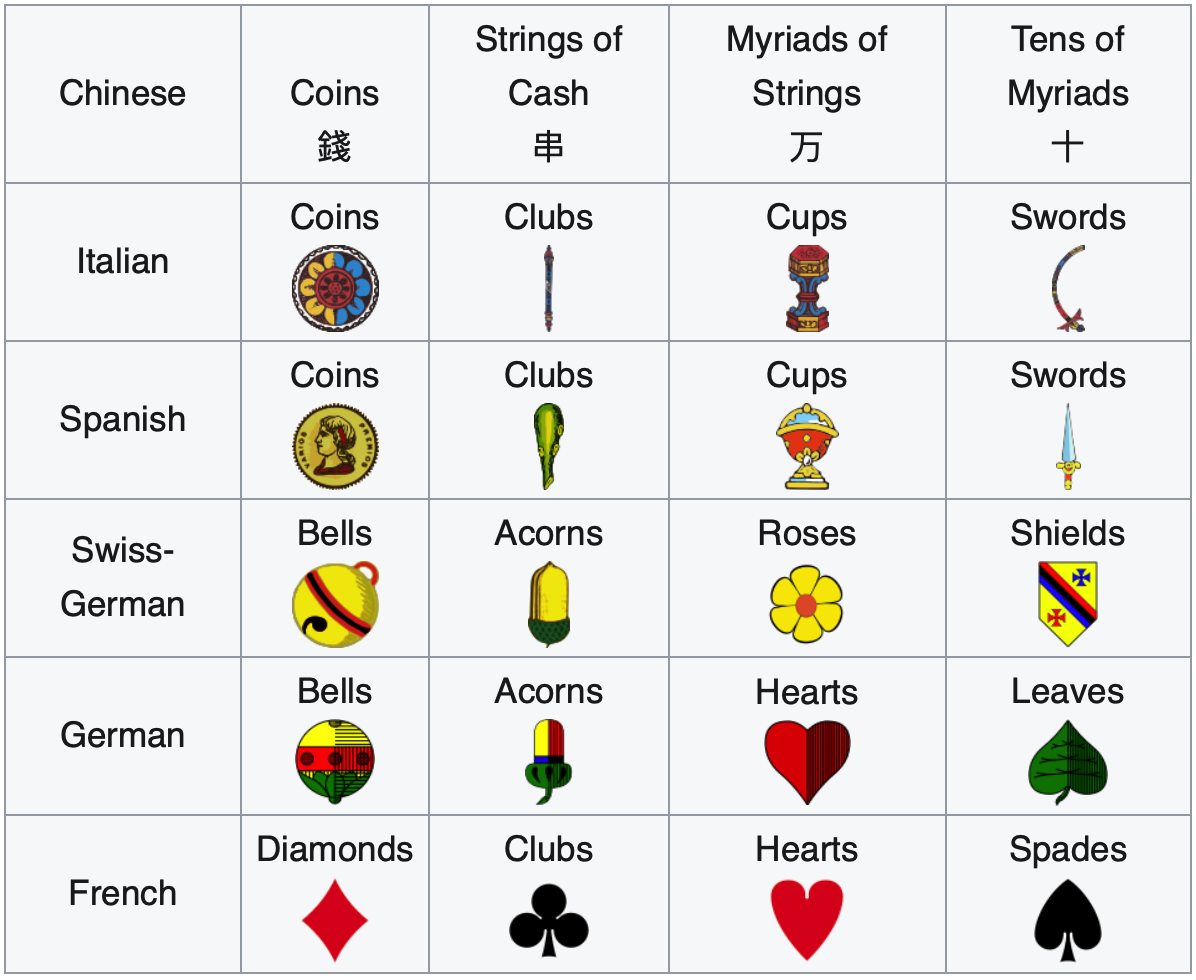This is an excerpt from the second edition of my ebook, How to Design Card Games.
One of the earliest uses of suits in tabletop games comes from the 12th century. Chinese dominos first had two suits: the Chinese suit and the Barbarian suit (later renamed to the Civil suit and the Military suit, respectively, so as not to disrespect the “barbarians” that had taken over). Unlike modern understandings of suits, these suits were not visually indicated; players simply had to memorize which domino tile belonged to which suit. For instance, the domino tile with the value 1 and 3 (1-3) is in the Civil suit but the tiles 1-2 and 1-4 are in the Military suit. At some point, these dominos were published as a deck of cards:

“Chinese domino cards with civil suit on top and military on the bottom.” – From Wikipedia.
A deck of cards using money-based suits evolved next, with each suit representing a different unit of currency: Coins, Strings of Coins, and Myriads of Strings. (Chinese coins had a square hole in the middle, allowing them to be strung together.) Early decks may have had 27 cards: with the values from 1 to 9 in each suit.

“Xianfeng Coins – Large denomination coins and string of regular coins.” – From Wikipedia.
A fourth suit evolved from the Myriads suit: Tens of Myriads. Lu Rong in the 15th century described a 38-card deck that might be the first deck with four suits—
- Cash: 1 to 9 Cash.
- Strings of Cash: 1 to 9 Strings.
- Myriads of Strings: 1 to 9 Myriad.
- Tens of Myriads: 20 to 90 Myriad, Hundred Myriad, Thousand Myriad, and Myriad Myriad (11 cards in total, no 10 of Tens of Myriad, to avoid confusion).
As the Islamic world came into more frequent contact with China, it adapted its own suits from the Chinese suits, creating the Ganjifa deck. Perhaps inspired by the shape of the Chinese characters, the Myriads suit became Cups, and the Tens of Myriads suit became Swords. The Strings looked like sticks to someone unused to stringing together coins and became Polo-sticks. Coins remained Coins.

Source: A reconstruction of the Topkapi deck of Mamluk cards
In the first European decks, the makers of the Latin suit replaced the Polo-sticks suit with Clubs, as polo was not a widely known sport yet in Europe. German manufacturers in the 15th century experimented with different variations on these Latin suits. Shields—which had originally been added to create one of the earliest decks with five suits—ended up replacing swords in early Swiss-German four-suit decks. All the other suits were replaced as well: Coins with Bells, Clubs with Acorns, and Cups with Roses. A later German deck changed Roses to Hearts and Shields to Leaves.

The French adapted this German deck in the late 1400s, not realizing at the time that they were creating the deck that would spread around the world, to continents they weren’t even aware of. They restored Clubs, though in a stylized manner (or perhaps it is a stylized Acorn with the name of the older suit). They replaced Bells with Diamonds and replaced Leaves with Spades. And there the suits stayed for five centuries.
In the twentieth century, with the proliferation of dedicated deck card games, many designers switched to using colors for suits, though still typically with four different suits.

Source: Wikipedia
Your design challenge is to create a deck of cards with an unusual configuration of suits, then adapt a card game normally played with a regular deck of cards to your new deck!
For more design challenges, see How to Design Card Games.



You must be logged in to post a comment.